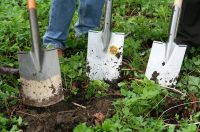
Dust off the spade and put your back into some autumn digging: with the soil still workable yet nice and damp from the autumn rains, it's the perfect time of year to turn new beds or improve established ones.
There's hot debate over whether or not digging is necessary: many don't dig at all, saying it destroys the soil's structure. Instead, they argue, it's better to let the worms draw a thick mulch of organic matter into the soil naturally.
That's certainly sound advice when your soil is already in good heart. But worms work slowly, and if you're bringing compacted or neglected land back into cultivation you'll want faster results.
Digging loosens the soil and gets rich, moisture-retentive organic matter into the root zone in double-quick time. Exposing clods of heavy clay to frost also breaks them down into more easily-cultivated pieces.
Sharpen your spade with a whetstone to help the blade slice easily into the soil. Then starting at the furthest corner, cut out a cube a spades' width across and deep and set it aside. Work methodically in rows, turning each spadeful upside down into the previous hole. Finish off by forking in organic matter for your plants to enjoy in spring.
